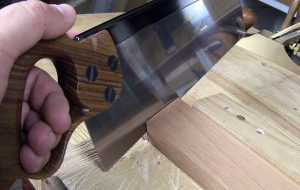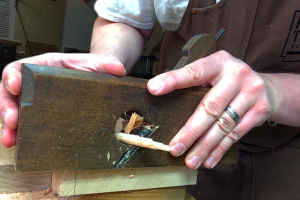Are You Preventing Yourself from Building Skills
 I’m building a kid’s table and chairs which is the 2015 Woodworkers Fighting Cancer project. The legs are raked 5° and each leg is comprised of 2 pieces laminated for additional thickness. This means that I have to make 4 angled cuts per leg and 16 cuts for all 4 legs. Now anyone will tell you that the actual degree of the angle is less important than the consistency of the angle from one piece to the other. Consistency sounds like a job for my miter box.
I’m building a kid’s table and chairs which is the 2015 Woodworkers Fighting Cancer project. The legs are raked 5° and each leg is comprised of 2 pieces laminated for additional thickness. This means that I have to make 4 angled cuts per leg and 16 cuts for all 4 legs. Now anyone will tell you that the actual degree of the angle is less important than the consistency of the angle from one piece to the other. Consistency sounds like a job for my miter box.
I started using a miter box to make the 5° cuts and realized that I was not getting cuts right on my angle either across the width or through the thickness of the board. So I fiddled with the box a bit then starting cutting again. A few cuts later and I found the angle was off again. So I fiddled some more. Somehow the miter box wasn’t holding its setting nor was it holding the saw firmly enough to eliminate any play.
It was then I had one of those out of body experience where I was looking down on myself messing around with this miter box and remembered that one of the things I love about hand tools is that you don’t have to mess around with fences and guides that regulate (and restrict) the cutting edge.
Make that same angled cut without the miterbox and it is just a matter of technique. Technique you can count on and fences and guides require trust that something else is doing its job. Call me a control freak but I know when I’m sawing accurately. The feedback from the blade and my stance, and my eyes tell me I’m splitting that line. When I rely on the miterbox to do this for me I lose control.
The beauty of a hand saw is say it with me now…
If you can see the line, you can saw the line
 I started asking myself, “why was I using the miter box in the first place, I can make that cut without it”
I started asking myself, “why was I using the miter box in the first place, I can make that cut without it”
Yes there is a learning curve to being able to nail a line across the width and through the thickness of a board, but your reward is infinitely more valuable than spending the time to fine tune some jig or machine to hit the line for you. Freedom is the result of learning to do it “the hard way”.
Now a lot of you may be scoffing at me right now thinking that I lose repeat-ability with that guided angle or a stop block allowing me to cut each piece to exactly the same length. But I have to respond as to whether that is actually needed at this point. Regardless of whether a miter box guided the saw or my arm guided the saw, I would be visiting the edge with a plane to clean up the cut. So I grabbed my bevel gauge that I have already set so I could set the miter box against and marked a line on the board…and sawed to it. Guess what, my cut was more accurate and I powered through the last 9 pieces in less than a minute. Woodworking level up!
This is not an anti jig rant. To prove it I will say that most likely I’ll be making this clean up plane pass using a jig called a shooting board with a custom angle fence. There is nothing wrong with getting a little help but the key is to remember at what point it actually will make a difference. I may end up fiddling with the shooting board to dial in the cuts but now it counts when it comes to how the parts will actually fit together. Even then a shooting board is pretty straight forward and there aren’t any moving parts that need to be adjusted so I doubt anyone is going to be fiddling with it very much.
My point is that I got into hand tool work so I could rely on my own skills to guide and power my tools. I hate machine maintenance and cringe at the hours I spend messing around with a machine to get it cutting correctly. With my hand tools I just need to make sure my edges are sharp, the rest comes from my own skill. When your own skill bails you out of tight spots, it is a truly liberating and empowering feeling.
Fences and guides and stops are not evil, please don’t misunderstand me. I could put some time into my miter box and get it more consistent but it doesn’t change the fact that I don’t need that level of precision at that stage of the game. Inserting a tool that regulates the movement of my saw is just selling my own skills short when I know I’m only going to refine the edge with a shooting board later. Once you get around that and begin to build your skill as a sawyer, you might be surprised at how accurate your cuts start to become in the first place. Now you are spending even less time at the shooting board. Or you skip the shooting board completely and just run a plane over the edge to clean up the saw marks because that edge is already at the right angle and perfectly square.For those of you thinking to yourself, “I’ll keep using my miter box until my sawing skills get better”. Ask yourself, how will you improve your sawing skills if you keep relying on the miter box to guide the saw? I know I have picked on the miter box once already but this is only one example of many where our gadgets might be holding us back.
Your Turn
Can you think of other tools/techniques that might hold us back from building our skill?



